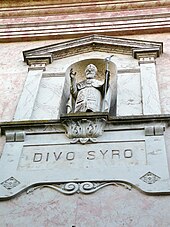Syrus (saint)
Syrus ( Italian San Siro ; † probably in the 4th century in Pavia ) was the first traditional bishop of Pavia ; legend dates him to the first century and connects him with St. Hermagoras .
life and work
The text De laudibus Papiae , written in the 14th century, sees Syrus as the boy who gave Christ five loaves of bread, which he increased into 5000 loaves ( Jn 6.9 EU ). A legend from the 8th century makes him a disciple of Saint Hermagoras, who was a disciple of Peter and the first bishop of Aquileia . Hermagoras sent Syrus together with Juventius to Pavia (then Ticinum Papiae ), where Syrus became bishop.
Its effectiveness is said to have extended to Lorch in Upper Austria . He consecrated the saints Chrysanthus and Fortunatus as priests and appointed Juventius and Pompeius as his successors in the episcopate. In fact, the lists of bishops for Pavia name Syrus, Pompeius and Enventius as the first bishops of the city, but date them to the 4th, not the 1st century, so that there is probably a later, early dating to give the diocese a more venerable age and connection to provide the apostles.
The relics of Syrus have been kept in the Cathedral of Pavia since the 9th century . They are there in a glass shrine of the altar dedicated to him. Numerous churches in Italy are named after Syrus, and today's Giuseppe Meazza Stadium in Milan was also named San Siro for a long time , named after the district of the same name in which it is located.
The day of remembrance of Syrus is December 9th .
literature
- Ekkart Sauser : Syrus of Pavia. In: Biographisch-Bibliographisches Kirchenlexikon (BBKL). Volume 19, Bautz, Nordhausen 2001, ISBN 3-88309-089-1 , Sp. 1372.
- Syrus, p . In: Johann E. Stadler , Franz Joseph Heim, Johann N. Ginal (eds.): Complete Lexicon of Saints ... , Volume 5 (Q-Z), B. Schmid'sche Verlagsbuchhandlung (A. Manz), Augsburg 1882, p. 414 .
Web links
| personal data | |
|---|---|
| SURNAME | Syrus |
| ALTERNATIVE NAMES | Siro |
| BRIEF DESCRIPTION | legendary bishop of Pavia |
| DATE OF BIRTH | 3rd century or 4th century |
| DATE OF DEATH | 4th century |
| Place of death | Pavia |
